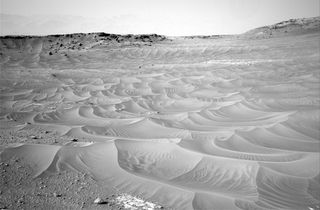Curiosity Rover Surveys Wind-Rippled Sandy 'Sea' on Mars (Photo)

At first glance you’d be forgiven for thinking NASA’s Mars rover Curiosity had stumbled across a wind-rippled lake or sea at the base of Mount Sharp. But on closer inspection of new images captured by the robot’s Navcam, we realize that the apparent "waves" in this Martian vista are in fact ripples of sand and dust.
PHOTOS: Curiosity Snaps Selfies, Begins Mars Rock Drill
After a 778-sol (Mars day) drive since landing in August 2012, the six-wheeled rover finally reached the base of its ultimate destination, Mount Sharp, last month. The 3.5 mile-high mountain in the center of Gale Crater holds great scientific promise; its rocky layers are an open history book of sorts, providing valuable information about the planet’s geological history and its potentially habitable ancient environment.
Currently, the rover is working in "Pahrump Hills" — an outcrop at the mountain's base — after carrying out its fourth rock drilling operation on a target dubbed "Confidence Hills." The drilled powder, which appears to be of a softer consistency compared with previous rock samples, has been ingested into Curiosity's onboard chemical lab to determine what the base of Mount Sharp is made of.
NEWS: Mars Rover Curiosity Drills into Mount Sharp
In this new observation (see the full resolution raw image here), Mars' windy environment is obvious. There are many examples of aeolian (wind-blown) features across the Martian surface, including vast dune fields and wind erosion of small hills known as mesas. Many of these features can only be seen from orbit, but Curiosity has a ground-level view of small-scale features such as these sandy waves resembling a choppy sea.
As Curiosity continues its drive up Mount Sharp over the coming months and — possibly — years, we can expect many more stunning examples of Mars' diverse geology and elegant wind-blown features, each observation helping us better understand the Red Planet’s evolution to its current form.
Get the Space.com Newsletter
Breaking space news, the latest updates on rocket launches, skywatching events and more!
This article was provided by Discovery News.
Join our Space Forums to keep talking space on the latest missions, night sky and more! And if you have a news tip, correction or comment, let us know at: community@space.com.
Ian O'Neill is a media relations specialist at NASA's Jet Propulsion Laboratory (JPL) in Southern California. Prior to joining JPL, he served as editor for the Astronomical Society of the Pacific‘s Mercury magazine and Mercury Online and contributed articles to a number of other publications, including Space.com, Space.com, Live Science, HISTORY.com, Scientific American. Ian holds a Ph.D in solar physics and a master's degree in planetary and space physics.
